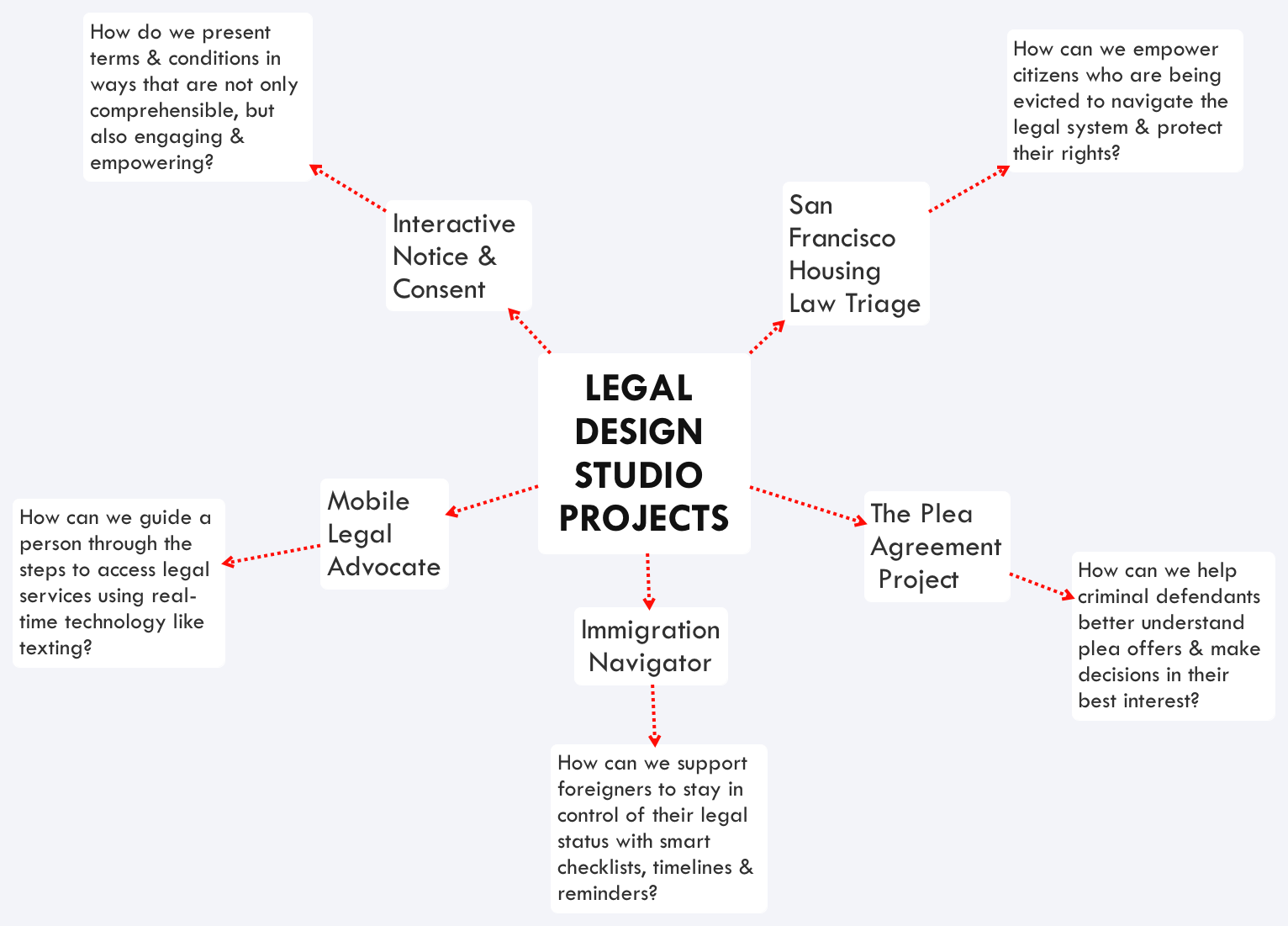This quarter, our program is initiating a new experiment in how to help law students & lawyers make innovations in legal service. We are working in a small design studio environment to coach students from idea to a pilot-ready product or service. We had many applicants to join the group, but selected only a handful for this quarter’s first iteration.
You can see the projects as they are currently defined in the above mindmap — but that’s not to say there will not be some pivots over the next two months of work.
The students work largely as individuals, though there are some pairs working together. But in design studio fashion, each of the individuals is constantly checking in & sharing their process, getting feedback & input, and asking for others’ expertise and help. Each applicant had to have a well-formed idea of what area of law they wanted to design in, and then the studio works to help them define their user, the central need, and then prototype & test the first few versions of their product or service.
Our Objectives:
I developed the design studio in response to two types of legal innovation curriculum I experienced.
- The first flawed model of legal innovation is giving a group of students a large topic to try to research and then design for. This sounds good in theory, but it soon becomes clear that smart people put together cannot simply arrive at innovative solutions by talking or reading about the problem. They need process and skills. It is essential to give a structure about how to develop ideas into working prototypes, as well as to equip the students with tech and design skills to build (at least) the first versions of web & mobile products. Otherwise, the projects often end up as blue sky (never-to-be-implemented) concepts, or as anti-gravity machines that incorrectly rely on magical technology to solve problems, or as vague and overbroad projects that have no clear use cases. This is my attempt to design a training that avoids these traps.

- The second flawed model I’ve experienced is the business model challenge. This approach is more viability-centered, and tasks students with coming up with an idea that they think could have a market & profit opportunity. They are supposed to consider what their stages of roll-out will be, who their audience for the product will be, and how it can be sustained. This viability focus is wonderful — and a nice, practical antidote to the above blue-sky approach. But the flaw with the business model challenge is that it ignores the actual product at the core of the business. The details of the product are left almost as an afterthought, that other employees can implement. The projects that emerge out of this model are typically more focused on the organization of the business & distribution of hypothetical profits, rather than what quality product could actually attract users & make them love using the product. This approach ignores prototyping and testing, making the student less focused on building an innovative new model and rather scouting out market opportunities. After this type of class ends,
I am developing a model that focuses on the product & the user — how do we not only scout out opportunities to make money & serve unmet needs, but also to do it creatively, in ways that will deeply satisfy the user, and that will push new models of legal service. Building a sustainable business cannot involve just a 10 page document of hypotheticals, it must be based in products that have already been prototyped and tested. That should not come as a next stage, but at an initial one. And you cannot develop promising products by merely telling students to be innovative, you must train them with process and skills that most law students lack.
That said, the Design Studio has 3 objectives:
- Training: Learning the design process & tools, and working together to hone our skills;
- Feedback: Getting (& learning to give) input on our project ideas & prototypes;
- Progress: Pushing our projects from ideas & initial prototypes to robust & tested products that can be released to the public
Our Process:
Each week we start with a quick show & tell to hear where everyone is at. If the student has specific questions & needs feedback, this is the time to ask for it. The rest of the group can give their insights & suggestions.
Then we have a short design exercise, that we do as a group, which should model good behavior for what to be doing at this stage of developing a product.
Then for the rest of the time we have a working session, in which we work on our projects side by side & can ask for feedback & advice as needed. This is our studio time — to get things done & have each other as resources.
We are beginning to get each of the projects its own website, so that its process can be public, and also its prototypes can be open for feedback via the Internet.
For example, check out the Plea Agreement Project’s site.



